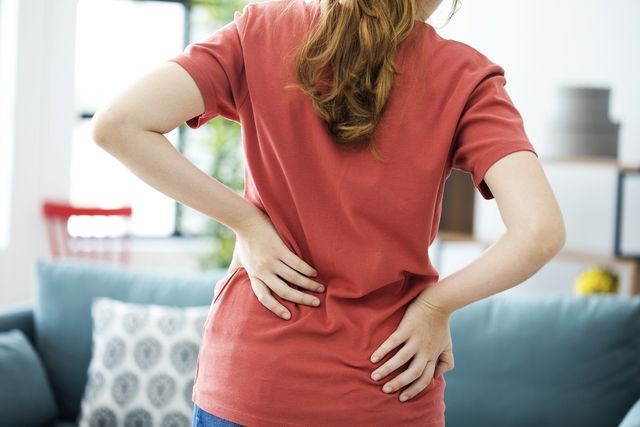Middle back pain is felt between the bottom of the neck and the start of the rib cage. It is generally related to issues within the thoracic spine, which is made up of 12 vertebrae. The most common problems that cause middle back pain are poor posture, a herniated disc, osteoarthritis or even small fracture.
This type of pain can also occur with issues in organs found along this region, like the lungs or stomach.
If you feel mid back pain, you should see your family doctor to evaluate the cause behind it. The doctor may refer you to a more appropriate specialist for treatment.

1. Poor posture
Poor posture throughout the day is one of the main causes of pain anywhere in the back. It is particularly felt with prolonged sitting with a rounded back. This can occur due to constant pressure or weight on the spine, which ends up overloading the muscles and ligaments in the spine.
What to do: Be aware of your posture throughout the day, especially if you work hunched over all day. Be sure to take pauses throughout the day to perform stretches for back and neck pain.
2. Muscle knots or injury
Just like bad posture, muscle knots or injuries are one of the main causes of mid back pain. These types of injuries are more frequent in people who workout with heavy weights, but they can also happen around the house when picking up heavy objects without proper body mechanics.
What to do: You should rest and apply warm compresses to help relax affected muscles. Local massage can help to reduce inflammation and improve any discomfort.
3. Herniated disc
A herniated disc occurs when a disc between the vertebrae bulges out of place. It can cause constant pain that worsens with movement. Some people also experience tingling or burning in the back that radiates to an arm or leg.
A herniated disc usually occurs as a result of chronically poor posture, but picking up heavy objects without bracing your back, but it can also happen with picking up heavy objects. Check-out the different types of hernias and what causes them.
What to do: If you suspect you have a herniated disc, you should see an orthopedic surgeon to assess your back and start appropriate treatment. Treatment may involve the use of analgesic or anti-inflammatory medication, while some cases may require surgical repair.
4. Osteoarthritis
Although it is rare, osteoarthritis can also cause middle back pain. This condition is associated with gradual breakdown of the cartilage between the vertebrae, which causes bones to rub on each other. Pain is the main symptom, and it often worsens overtime.
What to do: You should see an orthopedic surgeon to confirm a diagnosis and start treatment as necessary. The doctor will often recommend physiotherapy, however surgery may be considered if conservative treatment is not effective.
5. Spinal compression fractures
With aging, it is normal for bones to become more fragile. Many older adults experience microfractures along the vertebrae, especially with compression from an accident, fall or direct blow. The pain from a fracture is usually very intense and sudden, but it can also come on gradually.
In addition to pain, a compression fracture can also cause tingling that radiates to the arms, hands or legs.
What to do: Although these fractures are very small, they can worsen if left untreated. Therefore, if you suspect a fracture, you should see an orthopedic surgeon. Avoid any strenuous activity until you have been assessed.
6. Lung problems
Sometimes, back pain may no tactually be related to the spine or back muscles. It can emerge with lung issues, especially if more pain is felt with breathing, In these cases, you may also experience symptoms like shortness of breath or persistent coughing. See the different causes of lung pain and what to do.
What to do: If your back pain is associated with other lung symptoms, you should see your family doctor to assess for any abnormalities or infections that require treatment.
7. Stomach problems
Similarly to the lungs, when the stomach suffers from a condition like a reflux or ulcer, the pain can radiate to the mid back. People with stomach problems will often also notice burning in the throat, indigestion and vomiting. Read more about what can cause stomach and back pain.
What to do: If you think your back pain is related to a stomach issue, you should see a gastroenterologist. Until you are assessed, be sure to maintain a healthy diet that is free from fried food, fatty food and sugar.
When to see the doctor
In most cases, pain in the middle of the back is not a serious symptom. Nonetheless, it is possible for this pain to be caused by urgent conditions, like an infarct. Therefore, you should proceed to the hospital if you also have any of the following symptoms:
- Chest tightness
- Fainting
- Difficulty breathing
- Difficulty walking
If your pain lasts for over a week, you should see your family doctor or orthopedic surgeon to identify a cause of the pain and initiate treatment as needed.
